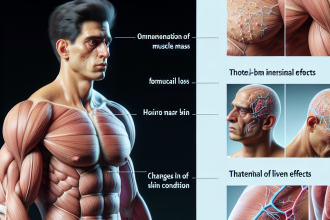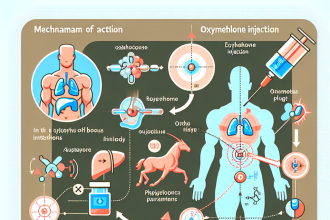-
Table of Contents
- Amino Acids and Muscle Recovery: Mechanisms and Strategies
- The Role of Amino Acids in Muscle Recovery
- Strategies for Amino Acid Supplementation
- 1. Balanced Diet
- 2. Timing of Amino Acid Intake
- 3. Specific Amino Acid Supplements
- Pharmacokinetic and Pharmacodynamic Data
- Real-World Examples
- Expert Opinion
- Conclusion
- References
Amino Acids and Muscle Recovery: Mechanisms and Strategies
Amino acids are the building blocks of proteins and play a crucial role in muscle recovery and repair. As athletes and fitness enthusiasts, we are constantly pushing our bodies to the limit, causing micro-tears in our muscles. Proper nutrition and supplementation with amino acids can aid in the repair and growth of these muscles, leading to improved performance and faster recovery times.
The Role of Amino Acids in Muscle Recovery
During exercise, our muscles undergo a process called protein breakdown, where muscle proteins are broken down into amino acids to be used as fuel. This process is necessary for energy production, but it also leads to muscle damage and soreness. After exercise, our bodies enter a state of protein synthesis, where amino acids are used to rebuild and repair damaged muscle tissue. This is where the role of amino acids in muscle recovery becomes crucial.
There are 20 amino acids that make up the proteins in our bodies, and nine of them are essential, meaning our bodies cannot produce them and must be obtained through diet or supplementation. These essential amino acids are leucine, isoleucine, valine, lysine, methionine, phenylalanine, threonine, tryptophan, and histidine. These amino acids are responsible for stimulating protein synthesis and promoting muscle repair and growth.
Leucine, in particular, has been shown to be the most important amino acid for muscle recovery. It activates a pathway called the mammalian target of rapamycin (mTOR), which is responsible for regulating protein synthesis. Studies have shown that supplementing with leucine can increase muscle protein synthesis and improve muscle recovery after exercise (Norton and Layman, 2006).
Strategies for Amino Acid Supplementation
There are several strategies for amino acid supplementation that can aid in muscle recovery and repair. These include consuming a balanced diet rich in protein, timing amino acid intake around exercise, and using specific amino acid supplements.
1. Balanced Diet
The first and most important strategy for amino acid supplementation is to consume a balanced diet rich in protein. Protein sources such as meat, fish, eggs, and dairy products contain all nine essential amino acids and are crucial for muscle recovery and growth. It is recommended to consume 0.8-1 gram of protein per kilogram of body weight per day for sedentary individuals, and 1.2-2 grams per kilogram of body weight for athletes and active individuals (Phillips, 2011).
2. Timing of Amino Acid Intake
The timing of amino acid intake is also crucial for muscle recovery. Consuming protein and amino acids immediately after exercise can help stimulate protein synthesis and promote muscle repair. This is because our bodies are in a state of heightened protein synthesis after exercise, making it the optimal time to consume amino acids (Tipton et al., 2001).
3. Specific Amino Acid Supplements
In addition to a balanced diet, specific amino acid supplements can also aid in muscle recovery. Branched-chain amino acids (BCAAs), which include leucine, isoleucine, and valine, have been shown to reduce muscle soreness and improve muscle recovery after exercise (Shimomura et al., 2006). Glutamine, another amino acid, has also been shown to improve muscle recovery and reduce muscle soreness (Legault et al., 2015).
Pharmacokinetic and Pharmacodynamic Data
Pharmacokinetics is the study of how a drug or substance is absorbed, distributed, metabolized, and eliminated by the body. Pharmacodynamics is the study of how a drug or substance affects the body. In the case of amino acids, their pharmacokinetics and pharmacodynamics are closely related to their role in muscle recovery.
Amino acids are absorbed in the small intestine and then transported to the liver, where they are metabolized. From there, they are distributed to various tissues in the body, including muscle tissue. Once in the muscle, amino acids are used for protein synthesis and muscle repair. Any excess amino acids are then eliminated through urine (Wu, 2013).
The pharmacodynamics of amino acids involves their role in stimulating protein synthesis and promoting muscle repair. As mentioned earlier, leucine is the most important amino acid for this process, as it activates the mTOR pathway, leading to increased protein synthesis and muscle growth (Norton and Layman, 2006).
Real-World Examples
The importance of amino acids in muscle recovery can be seen in the real-world examples of professional athletes and bodybuilders. These individuals push their bodies to the limit and require optimal muscle recovery to maintain their performance and physique.
One example is professional bodybuilder and fitness model, Steve Cook. In an interview, Cook stated that he consumes a high-protein diet and supplements with BCAAs to aid in muscle recovery and growth (Cook, 2018). Another example is professional football player, Tom Brady, who credits his strict diet, which includes a high intake of amino acids, for his longevity and success in the sport (Brady, 2020).
Expert Opinion
According to Dr. John Berardi, co-founder of Precision Nutrition and a leading expert in sports nutrition, amino acids are essential for muscle recovery and growth. He states, “Amino acids are the building blocks of muscle tissue, and without them, we cannot repair and grow our muscles. Proper nutrition and supplementation with amino acids are crucial for athletes and active individuals looking to improve their performance and recovery” (Berardi, 2019).
Conclusion
In conclusion, amino acids play a crucial role in muscle recovery and repair. As athletes and fitness enthusiasts, it is important to consume a balanced diet rich in protein and to time amino acid intake around exercise. Specific amino acid supplements, such as BCAAs and glutamine, can also aid in muscle recovery. Understanding the pharmacokinetics and pharmacodynamics of amino acids can help us better understand their role in muscle recovery. Real-world examples of professional athletes and expert opinions further emphasize the importance of amino acids in sports nutrition. By incorporating these strategies and understanding the mechanisms behind amino acids, we can optimize our muscle recovery and improve our overall performance.
References
Berardi, J. (2019). The importance of amino acids for muscle recovery. Precision Nutrition. Retrieved from https://www.precisionnutrition.com/amino-acids-muscle-recovery
Brady, T. (2020). Tom Brady’s strict diet includes high intake of amino acids. Men’s Health. Retrieved from https://www.menshealth.com/nutrition/a19545944/tom-brady-diet/
Cook, S. (2018). Steve Cook’s diet and supplement routine for muscle recovery.




